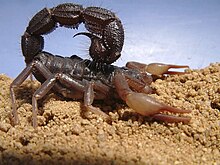비르톡신
Birtoxin| 비르톡신 | |
|---|---|
| 카테고리 | 이온채널 독소, 뉴로톡신 |
| 종. | 파라부투스트란스발리쿠스[1] |
| 대상 | 전압 게이트 나트륨 채널[1] |
| 증상 | 빈호흡, 경련, 떨림, 사망 |
| 분류 ID | 170972 [1] |
| 시퀀스 길이 | 58 AA [1] |
비르톡신은 남아프리카 스피팅 스콜피온(Parabuthus transvaalicus)의 독에서 나오는 신경독소이다.나트륨 채널 활성화를 바꿈으로써, 독소는 피레트로이드 살충제처럼 자발적이고 반복적인 발화를 촉진합니다.
원천
비독신은 남아프리카 스피팅 [1]전갈의 독으로부터 분리되었다.중간 정도의 독성이지만 독에 [1]매우 풍부한 펩타이드입니다.독에서 발견되는 다른 펩타이드 독소로는 치사성 펩타이드인 도톡신, 쥐에게 비틀림을 일으키는 베스트옥신, 그리고 매우 우울한 [2]펩타이드인 알티톡신이 있다.
화학
일반적으로 펩타이드 신경독은 60~70-잔류 범위의 '롱 체인 뉴로톡신'(LCN)과 6~8개의 시스테인 잔류물이 있는 30~40개의 펩타이드를 포함하는 '숏 체인 뉴로톡신'(SCN)의 두 가지 주요 패밀리로 나눌 수 있다.비르톡신은 베스톡신을 포함한 다른 비르톡신 유사 펩타이드와 함께 58개의 아미노산 잔류물로, '긴 사슬' 계열에 가깝지만 6개의 시스테인 잔류물을 가지고 있다.Birtoxin은 다른 LCN에 [3]비해 4개의 이황화 브릿지가 아닌 3개의 이황화 브릿지에 의해 그물화되므로 '롱 체인'[4][5][6][7] 계열과 '숏 체인' 계열의 진화적 연결고리로 여겨진다.
동작 모드
버톡신은 채널의 신경독 수용체 부위 4에 결합함으로써 나트륨 채널의 게이트 메커니즘에 영향을 미쳐 채널의 전압 역치를 낮추고 전류 진폭을 감소시킨다.활성화의 변화로 인해 나트륨 채널은 더 작은 탈분극에서 열립니다.이것은 흥분성을 증가시켜 경련, 지속적인 배뇨, 떨림, 그리고 빠른 [1][8]호흡과 같은 증상을 일으킨다.
독성
비독신은 포유류에게만 영향을 미친다.파충류, 곤충, 물고기에는 영향이 없습니다.쥐를 대상으로 한 실험에서는 주사 후 10분 만에 경련, 연속 배뇨, 떨림, 빈호흡 등의 증상이 나타났고 30분 동안 증가했다.1μg의 비독신 주입으로 24시간 동안 심각한 신경독성 효과가 발생했지만, 이 용량은 생쥐에게 치명적이지 않다.마우스의99 LD는 2μg에서 [1]달성된다.
버톡신 단백질 구조의 N 말단에 대한 항체는 남아프리카의 침 뱉는 전갈의 독을 중화시키는 것으로 보여졌으며, 이러한 항체는 침전 [9]치료에 임상적으로 유용할 수 있다.
레퍼런스
- ^ a b c d e f g h Inceoglu, B.; Lango, J.; Wu, J.; Hawkins, P.; Southern, J.; Hammock, B.D. (2001). "Isolation and characterization of a novel type of neurotoxic peptide from the venom of the South African scorpion Parabuthus transvaalicus (Buthidae)". European Journal of Biochemistry. 268 (20): 5407–5413. doi:10.1046/j.0014-2956.2001.02479.x. PMID 11606203.
- ^ Inceoglu, B; J Lango; I Pessah; B Hammock (2005). "Three structurally related, highly potent, peptides from the venom of possess divergent biological activity". Toxicon. 45 (6): 727–733. doi:10.1016/j.toxicon.2005.01.020. ISSN 0041-0101. PMID 15804521.
- ^ Martin-Eauclaire, M-F; Cearda, B.; Bosmans, F.; Rossoa, J-P.; Tytgat, J.; Bougisa, P.E. (1999). "New "Birtoxin analogs" from Androctonus australis venom". Biochemical and Biophysical Research Communications. 333 (2): 524–530. doi:10.1016/j.bbrc.2005.05.148. PMID 15963953.
- ^ Possani, L.D.; Becerrill, B.; Delepierre, M.; Tytgat Hammock, J. (1999). "Scorpion toxins specific for Na+-channels". European Journal of Biochemistry. 264 (2): 287–300. doi:10.1046/j.1432-1327.1999.00625.x. PMID 10491073.
- ^ Lebreton, F.; Delepierre, M.; Ramirez, A.N.; Balderas, C.; Possani, L.D. (1994). "Primary and NMR three-dimensional structure determination of a novel crustacean toxin from the venom of the scorpion Centruroides limpidus limpidus Karsch". Biochemistry. 33 (37): 11135–11149. doi:10.1021/bi00203a010. PMID 7727365.
- ^ Lebreton, F.; Delepierre, M.; Ramirez, A.N.; Balderas, C.; Possani, L.D. (1994). "Purification and primary structure of low molecular mass peptides from scorpion (Buthus sindicus) venom". Comparative Biochemistry and Physiology A. 121 (4): 323–332. doi:10.1016/S1095-6433(98)10140-X. PMID 10048185.
- ^ Gordon, D.; Savarin, P.; Gurevitz, M.; Zinn-Justin, S. (1998). "Functional anatomy of scorpion toxins affecting sodium channels". Toxin Reviews. 17 (2): 131–159. doi:10.3109/15569549809009247.
- ^ Cestèle, S.; Catterall, W.A. (2000). "Molecular mechanisms of neurotoxin action on voltage-gated sodium channels". Biochimie. 82 (9–10): 883–892. doi:10.1016/S0300-9084(00)01174-3. PMID 11086218.
- ^ Inceoglu, B; J Lango; A Rabinovich; P Whetstone; B Hammock (2006). "The neutralizing effect of a polyclonal antibody raised against the N-terminal eighteen-aminoacid residues of birtoxin towards the whole venom of Parabuthus transvaalicus". Toxicon. 47 (2): 144–149. doi:10.1016/j.toxicon.2005.08.018. ISSN 0041-0101. PMID 16356521.


